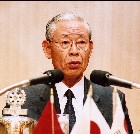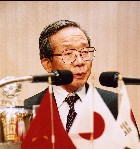Initiation Speech
March 1, 2006
Mr. Kunio Sakuma
Mr. Akira Nishikawa
 ��Story of Printing Ink��
��Story of Printing Ink��
Mr. Kunio Sakuma,
Representative Director and President,
Toyo Ink MFG. Co., Ltd.
There are some 40 printing ink manufacturers in Japan, and most of these were founded in the Meiji Era, around the time of the Sino-Japanese and Russo-Japanese Wars. The manufacture of printing ink, with some 110 years of history, was an industry that was deemed necessary with the changing social and living conditions. In particular, after World War II, with the introduction of leading technology, its use expanded dramatically, and printed items became visible in all life situations.
Now, the global market for the printing ink business is roughly \2 trillion annually, and there are 10-odd major players in the market, including Japanese, European, and US companies. Global printing demand in 2003 was about \74 trillion, but is projected to reach \88 trillion by the year 2010. A breakdown of the global printing market by regions shows Asia holding a 37% share, followed by North America with 33%, Central Europe with 23%, Central and South America with 3%, Eastern Europe with 2%, and the Middle East and Africa with 2%. Among the 37% share held by Asia, Japan��s 10% is included. Going forward, by 2010, with the growth of the BRICs markets, Asia, South America, and Eastern Europe are expected to increase their shares to 40%, 4%, and 3%, respectively, while the North American share is projected to show a decline. ��
In technology development in printing ink now and going forward, I feel that the following two themes are essential.
First is making products that are compatible with the environment. No product that has been printed and processed should be a root that emits harmful substances.
Second is the development of functional product materials that are compatible to ink jets and the like used in flat panel displays, including liquid crystals, IC tags, and advertising on vehicles.
In the above two areas, I believe that the Japanese printing ink manufacturing industry has taken the global leadership position. We are making continuous efforts toward the goals of information transmission through print media, providing safety of product packaging, and providing a comfortable life through the development of functional materials.
 ��The beginning of civilization was an encounter with copper��
��The beginning of civilization was an encounter with copper��
Mr. Akira Nishikawa,
Director and Advisor,
Mitsubishi Materials Corporation
When pithecanthropus, the progenitor of humans, first appeared on earth is said to be some 1 million to 4 million years ago. Homo sapiens, having similar physical attributes as the present-day humans appeared about 50,000 years ago, after a glacier age that stretched over some 1 million years.
After a long period of hunting and collecting, humans mastered the use of fire. This enabled the flourishing of farming life and developed into the manufacturer of tools to store crops such as earthenware. Through the Stone Age, the Bronze Age, the Iron Age, up to the present, at each juncture of the periods new materials and tools appeared.
The first metal to be first handled by our ancestors was copper. About 8,000 B.C, humans discovered natural copper that was naturally separated and learned to use it. About 6,000 BC, technology was enhanced where metals were able to be manufactured by reducing oxidized ores. The foundation was the manufacturing technology of making earthenware using high temperatures that they had accumulated through experience. The temperature within the pot was some 700 to 800 degrees Celsius, and this can also be educed by the fact that this temperature is about the same as the temperature to reduce oxidized ores. This was the birth of metallurgy and the beginning of a glorious metal age.
In order for the full-fledged use of copper, an appearance of bronze, an alloy of copper and tin, was needed. The mixed smelting of copper and tin is thought to have been coincidental. It took mankind some 1,000 years to obtain bronze from making an alloy of copper and tin.
Encounters with metal enabled a dramatic development in human civilization. There is a document evidencing an opening of a copper mine on the Sinai Peninsula around 3800 B.C. Copper was widely transported to the Mediterranean region, and began to be used widely. Copper and copper alloys are being used as basic materials for wide variety of equipment parts in addition to the traditional usage for transmission of electrical energy.
Copper, supported by miniaturization, alloying, and compounding technologies, will likely further enhance its importance in nano-sized productions.